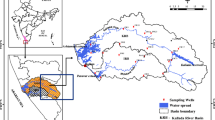Abstract
A detailed water quality analysis was carried out in the quaternary aquifer system of the marginal alluvial plain (Ganga Plain) in Bah Tahsil, Agra district, India. The electrical conductivity of 50 samples each from dug wells, hand pumps and tube wells was analysed for the study of salinity levels in shallow, intermediate and deep aquifers. Out of 50, 20 samples of each were also analysed for other chemical constituents such as Na+, K+, Cl−, F− and TDS. The analyses show drastic changes in the salinity levels of shallow, intermediate and deep aquifers. The deep aquifers are more saline compared to the shallow and intermediate aquifers. On the contrary, the concentration of chemical constituents such as Na+, K+, Cl− and F− was more in the shallow aquifers compared to the deep aquifers. Moreover, there is an indication that the salinity and concentration of the above chemical constituents also escalate with time in each aquifer. The chemical constituents such as Na+, K+, Cl−, F− and TDS range from 51 to 165 mg/l, 1 to 14 mg/l, 224 to 1,459 mg/l, 0 to 1.5 mg/l and 750 to 2,650 mg/l, respectively. Over a 3-year period, the salinity levels have sharply increased and the average F level has increased by 0.1–0.3 mg/l. An attempt has been made here to discuss the factors causing the variation and escalation of chemical constituents and salinity in the water of the three aquifers.








Similar content being viewed by others
References
Bhargava GP, Abrol IP, Kapoor BS, Goswami SC (1981) Characteristics and genesis of some sodic soils in the Indo-Gangetic alluvial plains of Haryana and Uttar Pradesh. J Indian Soc Soil Sci 29(1):61–70
Brown E, Skougstad MW, Fishman MJ (1974) Methods for collection and analyses of water samples for dissolved minerals and gases. US Department of Interior, Book No. 5, p 160
CGWB (2003) http://www.cgwblucknow.up.nic.in/geophysicsstudy.htm#dmap1
Drury JS, Ensminger JT, Hammonds AS, Hollem JW, Lewis EB, Preston EL, Shriner CR, Towill LE (1980) Review of the Environmental effects of Pollutants, IX Flouride. US Environmental Protection Agency, Cincinnati, 549 p
Gupta SK, Gupta IC (1987) Management of saline soil and water. Scientific Publishers, Jodhpur
Inland Salinity in India (1994) Central Soil Salinity Research Institute, Karnal
IUGG (2003) Indian national report for 23rd general assembly. International Union of Geodesy and Geophysics, June 30–July 11, 2003, Sapporo
Kapoor BS, Singh HB, Goswami SC, Abrol IP, Bhargava GP, Pal DK (1981) Weathering of micaceous minerals in some salt affected soils. J Indian Soc Soil Sci 29:286–492
Kumar R (1998) Role of Himalayan Orogeny in the formation of salt affected soils of the Indian sub-continent. In: Proceedings of 16th World Congress of Soil Science, held at Montpellier, August 20–26, 1998. Symposium: 15 Reg No: 277
Kumar R, Ghabru SK, Ahuja RL, Singh NT, Jassal HS (1993) Clay minerals in the alkali soils of Ghaggar river basin of Satluj–Yamuna divide in North-West. Clay Res 12:43–51
Kumar R, Ghabru SK, Ahuja RL, Singh NT, Jassal HS (1995) Elemental and mineralogical composition of the coarse fraction of the normal and alkali soils of the Satlu-Yamuna divide of North-West India. Clay Res 14:29–48
Ministry of Water Resources, Government of India (1997) Inland groundwater salinity in India. CGWB, Faridabad
Misra AK (2005) Integrated water resource management and planning for its sustainable development, using remote sensing and GIS techniques in dark areas of Agra and Mathura districts of Uttar Pradesh. Dissertation. University of Lucknow
Misra AK, Mishra A (2006) Groundwater quality monitoring in shallow and deep aquifers in Saidabad tahsil area, Mathura district, India. Environ Monit Assess 117:345–355
Misra AK, Saxena A, Yaduvanshi, M, Bhadauriya, Y, Mishra A, Thakur A (2006a) Proposed river linking project of India: a boon or bane to nature. Environ Geol (in press)
Misra AK, Mishra A, Premraj (2006b) Escalation of groundwater fluoride in Ganga alluvial plain, India. Fluoride 39(1):35–38
Salama RB, Otto CJ, Fitzpatrick RW (1999) Contributions of groundwater conditions to soil and water salinization. Hydrogeol J 7(1):46–64
Schoups G, Hopmans, JW, Young C, Wallender WW (2003) Soil salinization in irrigated agriculture: a regional scale analysis in the San Joaquin Valley, California. Geophysical Research Abstracts, vol 5, 12902. European Geophysical Society 2003
Singh IB (1996) Geological evolution of Ganga Plain: an overview. J Palaeo Soc India 41:99–137
State of the Environment Tasmania (2003) http://www.rpdc.tas.gov.au/soer/indicator/index.php
Tamta SR (1999) Occurrence and origin of groundwater salinity in Bhatinda district, Punjab. In: International seminar on applied hydrogeochemistry, Novermber 18–21, 1998. Annamalai University, Chidambaram, pp 113–122
Todd DK (1959) Groundwater hydrology. Wiley, New York
Tóth T, Kovacs D, Marth P (2006) Country-scale changes in salinity/sodicity/alkalinity of Hungarian soils as shown by the National Soil Monitoring Network (see http://www.crops.confex.com/crops/wc2006/techprogram/P16679.HTM). In: 18th World Congress of Soil Science, July 9–15, 2006, Philadelphia
Acknowledgments
The Council of Science and Technology, Uttar Pradesh Government, Lucknow is acknowledged for financial assistance (CST/AAS/D-2187). We thank Prof. M.P. Singh, Head, Department of Geology, University of Lucknow for providing working facilities and also for his continuous encouragement. We also thank Prof. A.K. Jauhri of the Department of Geology, University of Lucknow and Dr. Vandana Chaudhary of the Department of Science and Technology, New Delhi for critically reading the manuscript and offering many useful suggestions.
Author information
Authors and Affiliations
Corresponding author
Rights and permissions
About this article
Cite this article
Misra, A.K., Mishra, A. Escalation of salinity levels in the quaternary aquifers of the Ganga alluvial plain, India. Environ Geol 53, 47–56 (2007). https://doi.org/10.1007/s00254-006-0617-2
Received:
Accepted:
Published:
Issue Date:
DOI: https://doi.org/10.1007/s00254-006-0617-2




